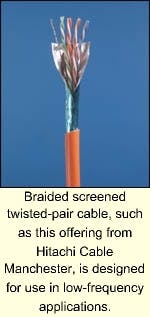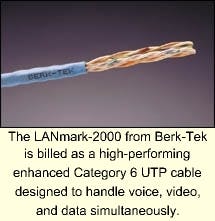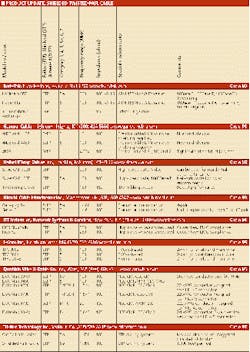When constructing a cabling system, few qualities are as important as protecting the signal. As the signal travels through the cable, it is subjected to various forms of degradation, from crosstalk to radiation. In the absence of a cabling super hero sweeping in to save lost signals, manufacturers have designed a wealth of products intended to provide safe passage with minimal interference. One such product is shielded twisted-pair (STP) cable.
In its infancy, STP was part of the IBM token ring system and gained prominence on the coattails of "Big Blue." Today, STP continues to provide an alternative to its more popular cousin, unshielded twisted-pair (UTP) cable. Available in several variations, STP most often features a shield around each twisted-pair of wires. The purpose, according to Dan Kennefick, copper products business manager for Berk-Tek (www.berktek.com), "is very simply, to prevent noise from interfering with the signal."
Harry van der Meer, director of technology for Helix/HiTemp Cables, Inc. (www.drakausa.com), points out that in addition to eliminating ambient noise, STP products attempt to protect the cable from radiation. This is one of the reasons for twisted-pair balance. "The reason for twisting is to have a cancellation effect between radiation and interference from outside," says van der Meer. Perfect balance should equate to zero radiation. Once the noise and radiation are eliminated, the signal is provided with a clear path.
Three types of STP
"Shielded twisted-pair" is a general term often used for three smaller cable types. The terms foiled, screened, and shielded all reference a cable that features an extra layer of protection. The problem is that definitions of each of the three terms have not been fully standardized among the various manufacturers. "The terms are ambiguous and not clear in the industry," explains van der Meer, "and it really depends on the manufacturer."
Foiled twisted-pair (FTP) is often defined as four pairs of twisted cable with an overall aluminum foil shield and bound in a plastic sheath. Quabbin Wire & Cable Co., (www. quabbin.com), uses the FTP structure for STP cable manufactured for use in T-1 lines and patch cords. This cable, says national sales manager Dick Stearns, is a 100-Ω cable designed with an oval shape for easy termination with 8-pin modular connectors.
The FTP structure is often used for high-frequency applications. "They are continuous with no breaks," says van der Meer. One drawback to FTP, he says, is difficulty in making connections because the foil does not fold easily.
According to Stearns, screened twisted-pair (ScTP) refers to cable that features an overall aluminum mylar shield. While often used interchangeably with FTP, ScTP can refer to an overall shield that is either foiled or braided, whereas FTP is typically limited to a strictly foiled design. The braided ScTP, according to van der Meer, is a "practical solution" for low-frequency applications. Companies such as General Cable (www.generalcable.com) and Quabbin offer screened products.
Shielded twisted-pair is the term used to describe this category of cable, and it is also used to refer to a specific category of products. Kennefick defines shielded twisted-pair as "each twisted-pair is shielded by either a foil or braid." The pairs are then covered by another overall shield. The complexity of definitions makes it essential that you understand product descriptions and functions before you buy for a particular installation.
Special considerations
While ambiguity surrounds product definitions, there is a general consensus that STP products are ideal for specific environmental conditions. Todd Leitheiser, an installer and supervisor with the U.S. Coast Guard in Kodiak, AK, sees the most use for STP cable in high-security projects-including banks, financial institutions, and government projects.
Industrial environments often require STP cable due to the amount of noise created by manufacturing and processing equipment. Any network located near possible interference is a candidate for STP.
According to an Anixter (www.anixter.com) white paper, UTP vs. STP, a shielded cable relies on the outer shield to block interference. In comparison, UTP "relies on the balancing and filtering techniques through filters and/or baluns." While there are a number of structural differences between UTP and STP cable, there is not always a drastic difference in the resulting levels of performance.
For example, General Cable offers horizontal STP cable that strives to exceed the same standards set for UTP cable through the EIA/TIA standards. Asef Baddar, applications engineer of data communications products, explains, "We have more head room than the standards require." Meeting the same requirements as General Cable's UTP offerings is a feat, according to Baddar, since there is another physical layer to STP cable.
Electromagnetic interference (EMI) is potentially the most crucial issue when dealing with STP. EMI causes noise and is brought about by outside sources, such as power lines or radar signals. Kennefick says that one primary purpose of shielding "is to prevent electromagnetic energy from leaving the cable and prevent outside interference from coming into the cable." When these forces are allowed to penetrate the cable, bit-errors can result.
Blocking EMI is typically cited as a key reason for using STP, but Anixter argues, "There is no real advantage to putting a shield over 4-pair 100-Ω cable just to keep out EMI/RF if the UTP is a properly designed and installed system."
With a spectrum of opinions on UTP versus STP, it is a decision you will need to make on an installation by installation basis.
Grounding is crucial
When installing STP, EMI must be addressed by grounding the cable. Anixter's Technical Library advises, "For high-frequency signals, an STP cabling system must be grounded, at a minimum, at both ends of the cable run and it must be continuous." If only grounded at one end of the system, the cable will lack a defense against magnetic field interference.
Firm guidelines for grounding are virtually impossible to outline because they must be both application- and location-specific. Helix/HiTemp's van der Meer says, "There are many areas in the United States where grounding is hard, due to soil conditions." Kennefick agrees with the importance of grounding and of having correctly trained installers: "Improperly grounded STP is worse than no shield at all."
STP must be grounded properly because "if the grounding of the shield is not done properly, it can start working as an antenna," observes van der Meer. Other drawbacks to STP, he says, are the additional labor needed for installation and a higher cost when compared with UTP. "It is a little more time-consuming because of grounding," says Leitheiser. The additional layer between the conductors and the jacket causes Leitheiser to be more cautious during the install. Extra time must be taken to protect the cable's integrity and to work with the multiple layers. Nevertheless, van der Meer says, STP can offer a "tremendous advantage in performance" as a result of its ability to protect signals from interference.
Evaluating STP
In its white paper analysis, Anixter advises against using STP for Category 5 or Category 6 installations. By adding this shield, Anixter says, the user will not gain more usable bandwidth for their money. The white paper adds that UTP cabling systems inherently have fewer points for potential failure.
STP cable is comparable from manufacturer to manufacturer, with only minor variations, such as the oval shape offered by Quabbin. General Cable's Baddar advises that you search for a manufacturer with both proven product performance and outstanding service. Further, an STP purchase should be weighed against both UTP and fiber, and evaluated for cost, installation time, and performance.
The future of STP products, in part, rests with the future of Category 7. According to van der Meer, structured cabling solutions up to Category 6 feature an overall shield designed to protect from outside interference. Category 7 is a 600 MHz design that has a shield around each pair.
"We are really the only manufacturer of plenum Category 7 because we do so much business in Europe," says van der Meer. Europe has been the primary playground for the STP cable players and this has recently come into the limelight with talk of Category 7 performance. Category 7 typically has very little crosstalk at both low and high frequencies, and can provide several times the bandwidth available with Category 5e products.
STP is popular in Germanic-speaking countries, such as Germany, Austria and Sweeden, but van der Meer predicts that STP makes up only 5% of the copper cable used in the United States. He expects to see small growth in the use of shielded cable as bandwidth increases and more people become concerned with radiation. "For some reason, they (Europeans/Germans) have strong feelings toward the impact EMI has on the human body-so they shield everything."
With the rise of fiber in the U.S., he says, it is doubtful that STP will reach the same levels of popularity it has enjoyed in Europe.
Michelle Abramsis Associate Editor for Cabling Installation & Maintenance.



